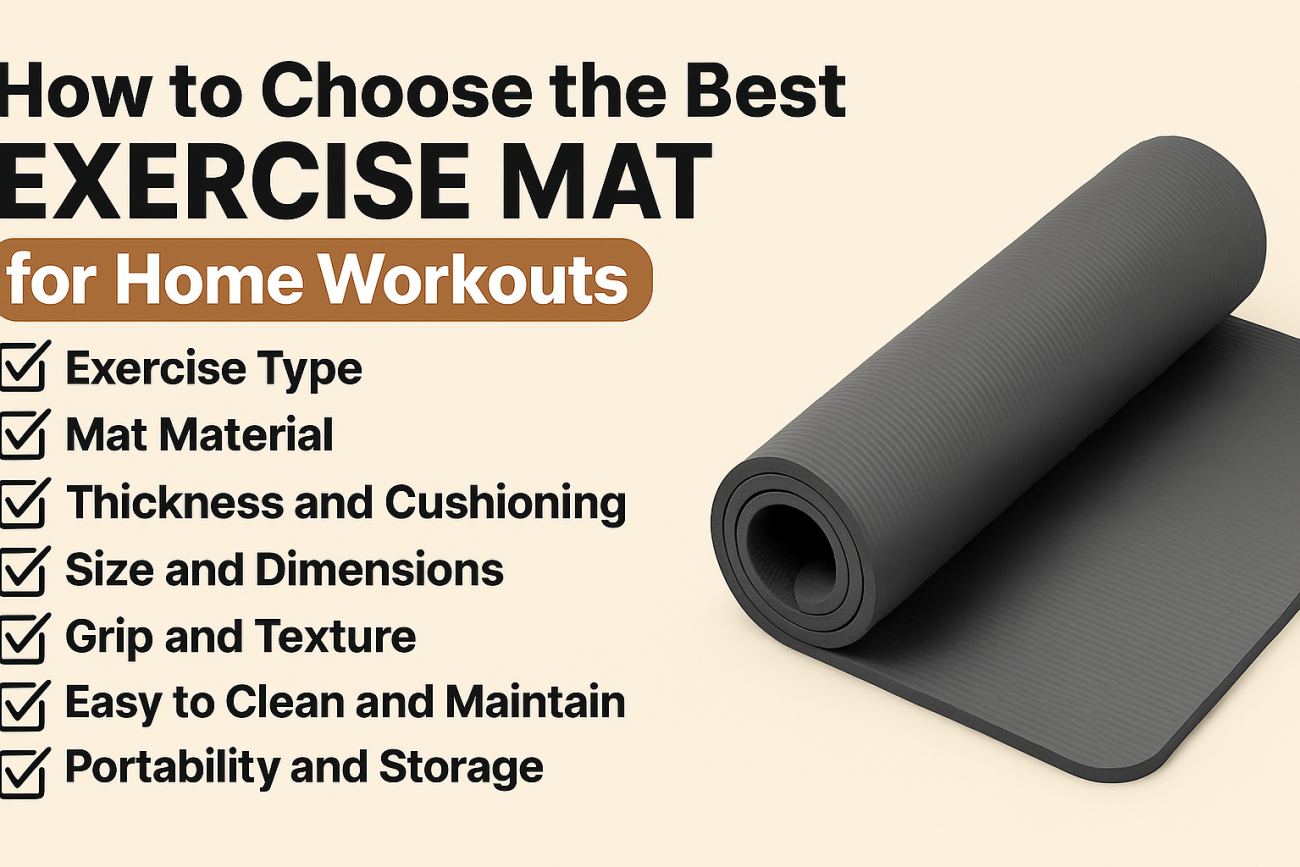Creating a comfortable and safe space for your fitness journey at home begins with choosing the right exercise mat. Whether you’re practicing yoga, Pilates, HIIT, or general floor exercises, the right mat provides the foundation for effective and enjoyable workouts. In this guide, we’ll explore the essential factors to consider when selecting the best exercise mat for home workouts, ensuring optimal support, durability, and performance.
Why Your Exercise Mat Matters
An exercise mat is more than just a piece of equipment; it’s your personal fitness zone. A quality mat can help protect your joints, absorb shock, prevent injuries, and provide stability during dynamic movements. Using the wrong mat, on the other hand, may result in discomfort, lack of support, or even damage to your flooring.
Key Factors to Consider When Choosing an Exercise Mat
There is a wide array of mats on the market, each designed for specific activities and preferences. Here are the main factors to take into account:
1. Exercise Type
- Yoga: Typically requires thinner mats (3-5mm) for stability during balance poses. Grip and non-slip surfaces are vital.
- Pilates: Often needs thicker mats (6-15mm) for cushioning and support during floor exercises.
- HIIT & Strength Training: Look for mats with shock absorption and durability to withstand high-impact movements and weights.
- General Fitness: Medium-thickness mats (5-10mm) are versatile for stretching, core, and light exercises.
2. Mat Material
The choice of material affects comfort, grip, durability, and eco-friendliness. Common materials include:
- PVC (Polyvinyl Chloride): Durable, affordable, and offers good cushioning and grip. However, not the most eco-friendly.
- TPE (Thermoplastic Elastomer): Lightweight, recyclable, and odorless. Good balance of eco-friendliness and performance.
- Natural Rubber: High grip and eco-friendly, but can be heavier and may contain latex (allergy alert).
- EVA Foam: Soft, lightweight, and shock-absorbing, but may wear out faster than other materials.
- Cotton or Jute: Sustainable and natural, but less cushioning. Often used as yoga rugs for a more traditional feel.
3. Thickness and Cushioning
Thickness influences comfort, support, and portability. Here’s how to choose:
- Thin Mats (3-5mm): Best for yoga and balance-focused workouts, offering firm support for stability.
- Standard Mats (6-10mm): Offer a balance between cushioning and stability. Suitable for most fitness routines.
- Thick Mats (10-15mm+): Ideal for Pilates, stretching, or sensitive joints. Provide maximum comfort but may reduce stability for balancing poses.
Consider your floor type too: thin mats may not provide enough cushion on hard floors like concrete or tile.
4. Size and Dimensions
Standard mats are typically 68 to 72 inches long and around 24 inches wide. However, taller individuals or those who want more room may prefer extra-long or extra-wide mats. For high-intensity workouts or activities with a lot of movement, a larger mat ensures you stay on the mat and off the hard floor.
5. Grip and Texture
Slip-resistance is crucial, especially for activities that involve sweating or fast-paced movements. Look for:
- Textured Surfaces: Enhance traction, preventing hands and feet from slipping.
- Non-slip Bottom: Prevents the mat from shifting on the floor during workouts.
6. Easy to Clean and Maintain
Hygiene is important, particularly for home gyms. Mats that are easy to wipe down or machine washable can save time and keep your workout space fresh. Some materials, like PVC and TPE, are naturally water-resistant and easy to clean.
7. Portability and Storage
If you need to store your mat away after each use or take it with you, consider weight and how easily it rolls up. Many mats come with carrying straps or bags, which add to their convenience factor.
Comparing Popular Types of Exercise Mats
Yoga Mats
Generally thinner with a sticky feel for great grip during poses. Best for yoga and stretching, but may not provide enough padding for high-impact exercise.
Pilates Mats
Thicker and softer, geared towards floor-based workouts, offering optimal cushioning for the spine and joints.
General Fitness Mats
Designed for versatility, these mats balance thickness and durability, suitable for a wide variety of exercises including strength, cardio, and stretching.
Specialty Mats
These include jump rope mats (designed for high-impact), puzzle-piece interlocking mats for home gyms, and foldable travel mats for those on the go.
Top Tips for Choosing the Best Exercise Mat
- Identify your primary activities before buying.
- Test out materials and thickness if possible for comfort.
- Read reviews for insight into durability and performance.
- Choose eco-friendly options if sustainability is important to you.
- Check return policies – comfort is personal!
Recommended Brands and Where to Buy
Popular exercise mat brands include Manduka, Liforme, Gaiam, Lululemon, BalanceFrom, and ProsourceFit. You can purchase mats from sporting goods stores, online retailers, or directly from brand websites. Always compare prices and look out for warranty offers.
Maintaining Your Exercise Mat
- Wipe down your mat after each session with a gentle cleaner.
- Allow it to air dry before rolling or storing it.
- For deep cleaning, follow manufacturer instructions—some mats are machine washable, others require hand-washing.
- Store your mat away from direct sunlight to prevent fading and warping.
Conclusion: Your Foundation for Home Fitness Success
Choosing the best exercise mat for home workouts is an important decision that directly impacts your comfort, safety, and motivation. By considering your workout style, material preferences, thickness, size, and ease of maintenance, you can find a mat that not only supports your fitness routine but also enhances your overall exercise experience. Invest in a quality mat and lay the groundwork for your healthiest self—right at home.
